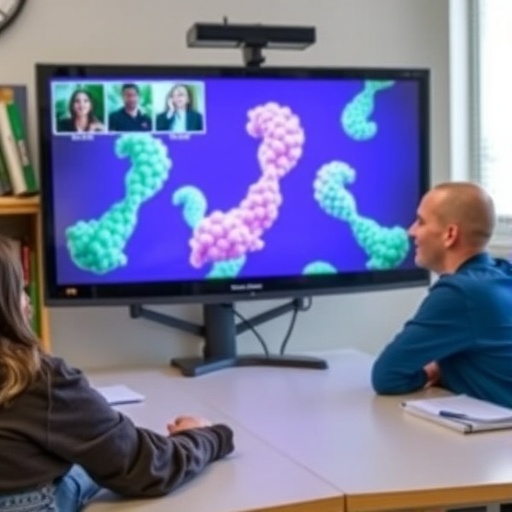In an era defined by rapid technological advancements in education, the flipped classroom strategy emerges as a revolutionary approach that is reshaping how students learn. This method, characterized by reversing traditional teaching paradigms, offers a fresh perspective on education, particularly in subjects often perceived as difficult, such as biology. Recent research conducted by Olana, Bacha, and Lemma highlights the profound impact of this strategy on secondary school students’ academic achievement in the biological sciences, marking a significant development in educational methodologies.
The flipped classroom model fundamentally transforms the role of the student from a passive recipient of information to an active participant in the learning process. Traditionally, lectures occupy the classroom, with students expected to absorb content, followed by homework assignments intended to reinforce this knowledge. However, the flipped classroom inverts this model. Students engage with instructional content at home through videos or readings and utilize classroom time for hands-on activities, discussions, and collaborative projects. This shift not only caters to diverse learning styles but also fosters a more interactive learning environment.
Research indicates that the effectiveness of the flipped classroom strategy is not incidental but stems from its ability to enhance student engagement. In the study led by Olana and colleagues, secondary school students participating in a biology class that implemented this strategy showed significant improvements in both their understanding of biological concepts and their overall academic performance. This finding aligns with previous studies suggesting that active participation in the learning process helps students retain knowledge better than traditional lecture-based methods.
Moreover, the flipped classroom strategy allows for increased personalization of learning. In the conventional model, teachers often struggle to cater to the varying pace at which students grasp new concepts. In a flipped classroom, students can learn at their individual pace, revisiting complex topics through recorded lectures or supplementary material at home. This self-directed approach not only empowers students but also provides teachers with opportunities to focus on one-on-one interactions during class, addressing specific individuals’ needs and questions.
One of the key components of the study conducted by Olana, Bacha, and Lemma was the integration of technology within the flipped classroom model. By utilizing online platforms, the researchers enabled students to access a wealth of resources beyond the traditional textbook. This access includes not only pre-recorded lectures but also interactive simulations and the latest research findings. By exposing students to real-world applications of biological concepts, the researchers aimed to cultivate a deeper understanding and interest in the subject matter.
Another significant aspect of the flipped classroom model is the collaborative nature of classroom activities. Students are encouraged to work together on problem-solving tasks or practical laboratory experiments that relate to their course content. This teamwork not only helps students develop essential social skills but also fosters a sense of community within the classroom. The findings from the study indicated that students who engaged in collaborative learning experiences reported higher levels of satisfaction and confidence in their abilities to grasp complex biological concepts.
Assessment in a flipped classroom also takes on a different approach. Instead of relying solely on traditional examinations, educators can incorporate various formative assessments that allow for a comprehensive understanding of student progress. In the case of the secondary school biology classes studied, the researchers employed quizzes, group presentations, and practical assessments to gauge student learning. This multifaceted approach to assessment not only provides valuable feedback for both students and educators but also aligns with modern educational practices emphasizing continuous improvement.
The transition to a flipped classroom requires careful planning and preparation from educators. It necessitates a shift in mindset, as teachers must be willing to relinquish control of the classroom environment. The Olana, Bacha, and Lemma study underscored the importance of professional development and support for educators as they implement this innovative strategy. Effective training programs that equip teachers with the necessary skills to create and integrate engaging online content are crucial to the success of the flipped classroom approach.
Feedback from students involved in the study further underscored the effectiveness of the flipped classroom. Many students expressed a newfound appreciation for biology, citing that the hands-on nature of the in-class activities bred a more enjoyable learning experience. Additionally, students reported feeling more capable of tackling challenging biological concepts due to the preparatory groundwork laid at home.
As educational institutions continue to evolve, the findings from this research present compelling evidence for adopting the flipped classroom model more broadly. While challenges such as ensuring equal access to technology persist, the potential benefits for student engagement and achievement in biology education are too significant to overlook. Further studies should aim to explore the long-term impacts of this strategy across various subjects and educational levels, and investigate how the successes seen in biology may translate to other disciplines.
In conclusion, the flipped classroom strategy represents a significant shift in educational paradigms, especially within the realm of biology education. Olana, Bacha, and Lemma’s research highlights the strategy’s potential to not only enhance academic achievement but also cultivate a more engaged and collaborative learning atmosphere. As educators seek innovative ways to improve student outcomes, embracing a flipped classroom approach may well be a pivotal step towards transforming educational practices for the better.
The integration of technology, personalized learning paths, and a collaborative classroom environment positions the flipped classroom as a formidable model in modern education. The success illustrated through this research offers a hopeful glimpse into the future of biology education and potentially other subjects, suggesting that by flipping the classroom, we might very well be flipping the narrative on student achievement.
Subject of Research: The impact of flipped classroom strategy on secondary school students’ achievement in biology.
Article Title: The impact of flipped classroom strategy on secondary school students’ achievement in biology.
Article References:
Olana, T., Bacha, K. & Lemma, A. The impact of flipped classroom strategy on secondary school students’ achievement in biology.
Discov Educ 4, 494 (2025). https://doi.org/10.1007/s44217-025-00942-4
Image Credits: AI Generated
DOI: https://doi.org/10.1007/s44217-025-00942-4
Keywords: Flipped classroom, biology education, student engagement, active learning, educational technology.




